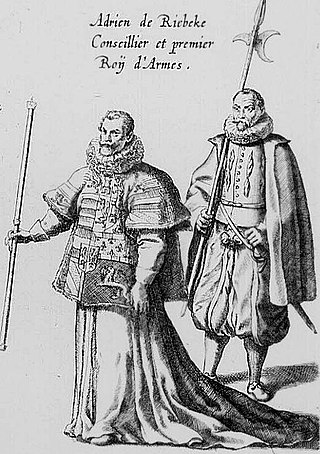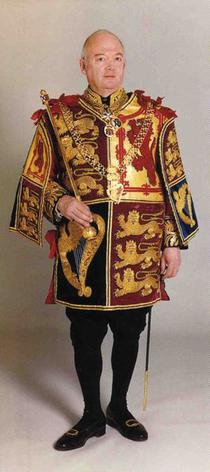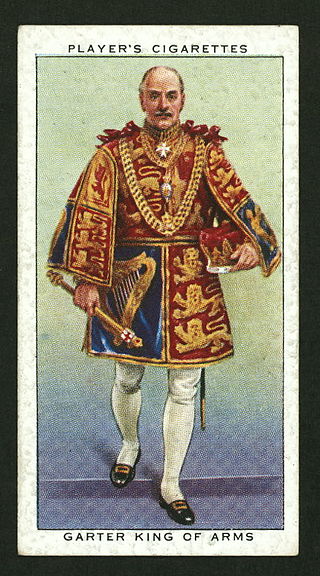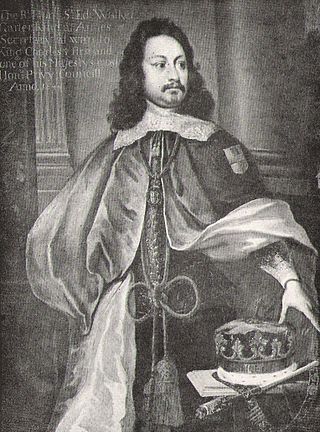
King of arms is the senior rank of an officer of arms. In many heraldic traditions, only a king of arms has the authority to grant armorial bearings and sometimes certify genealogies and noble titles. In other traditions, the power has been delegated to other officers of similar rank.

Norroy and Ulster King of Arms is the provincial King of Arms at the College of Arms with jurisdiction over England north of the Trent and Northern Ireland. The two offices of Norroy and Ulster were formerly separate. Norroy King of Arms is the older office, there being a reference as early as 1276 to a "King of Heralds beyond the Trent in the North". The name Norroy is derived from the Old French nort roy meaning 'north king'. The office of Ulster Principal King of Arms for All-Ireland was established in 1552 by King Edward VI to replace the older post of Ireland King of Arms, which had lapsed in 1487.

John Philip Brooke Brooke-Little was an English writer on heraldic subjects, and a long-serving herald at the College of Arms in London. In 1947, while still a student, Brooke-Little founded the Society of Heraldic Antiquaries, now known as the Heraldry Society and recognised as one of the leading learned societies in its field. He served as the society's chairman for 50 years and then as its president from 1997 until his death in 2006.

David Hubert Boothby Chesshyre was a British officer of arms.
Patric Laurence Dickinson is a former English officer of arms. He served as Clarenceux King of Arms from 2010 until 2021. He has worked at the College of Arms in London since 1968.

Sir Gerald Woods Wollaston was a long-serving officer of arms at the College of Arms in London. Wollaston's family had a firm tradition at the College of Arms. Wollaston's great-grandfather was Sir William Woods, Garter Principal King of Arms from 1838 until his death in 1842. His grandfather was Sir Albert William Woods who held the same post from 1869 to 1904.

Sir Algar Henry Stafford Howard was a senior British Army officer and long-serving officer of arms at the College of Arms in London. He served as the Garter Principal King of Arms from 1944 to 1950 before retiring. He was the third consecutive Fitzalan Pursuivant of Arms Extraordinary to attain the highest rank at the College of Arms.
Charles Harold Athill, MVO, FSA (1853–1922) was a long-serving officer of arms at the College of Arms in London.

Walter Aston Edward Blount Esq. FSA was a long-serving officer of arms at the College of Arms in London. He was born the eldest son of Edward Blount, the third, but second surviving, son of Sir Walter Blount, 6th Baronet of Sodington, Worcestershire.
Sir Charles Townley was a long-serving officer of arms at the College of Arms in London.

Heraldic visitations were tours of inspection undertaken by Kings of Arms throughout England, Wales and Ireland. Their purpose was to register and regulate the coats of arms of nobility, gentry and boroughs, and to record pedigrees. They took place from 1530 to 1688, and their records provide important source material for historians and genealogists.

Ireland King of Arms was the title of an officer of arms to the King of England and Lord of Ireland from 1392 until the accession of Henry VII as King of England in 1485. A king of arms is the highest of the three levels of officers of arms, and usually enjoys heraldic jurisdiction over a geographical area. Despite the name Ireland King of Arms did not appear to exercise heraldic authority in Ireland, and indeed the connection with Ireland seems rather tenuous. The office may have been created preparatory to a subsequently aborted military expedition to Ireland. The last holder of the office, Walter Bellinger, did exercise the heraldic prerogative of a king of arms to grant armorial bearings, however two of his grants were annulled or regranted by other kings of arms as they felt he encroached on their provinces. In 1552, 70 years after the last Ireland King of Arms, the office of Ulster King of Arms was created. The holders of this office exercised control over the heraldic affairs of Ireland until the death of its last incumbent, Major Sir Neville Wilkinson, in 1941. Thereafter, heraldic affairs within what later became the Republic of Ireland were transferred to the Government of Ireland while the jurisdiction of Norroy King of Arms expanded to include Northern Ireland when the present office of Norroy and Ulster King of Arms was established in the College of Arms.

Sir Edward Walker was an officer of arms and antiquarian who served as Garter King of Arms.
Sir Richard St George was a long-serving officer of arms at the College of Arms in London during the seventeenth century.
Roger Machado was an English diplomat and officer of arms of Portuguese extraction. He lived among the Portuguese merchants at Bruges in 1455.

Ralph Bigland was an English officer of arms, antiquarian and cheesemaker. He was born at Stepney, Middlesex, and was the only son of Richard Bigland and his wife, Mary. His father was a native of Westmorland, descended from the Bigland family of Biglands. He should not be confused with his nephew Sir Ralph Bigland, who also served as an officer of arms.

Thomas Hawley was a long-serving officer of arms at the College of Arms in London. He began his career of royal service as a groom porter to Queen Margaret of Scotland from her marriage in 1503 until 1508. Although he may have been made Rose Blanche Pursuivant in the reign of King Henry VII, his first permanent heraldic appointment came in 1509.
Thomas Benolt was a long-serving officer of arms at the College of Arms in London. As part of his service, he was also a diplomat. He appears to have been born at Rouen, though his family had stronger links with Calais. Benolt is thought to have been raised in that city, and his brother at one time became its secretary. Thomas Benolt is reported to have served Kings Edward IV and Richard III as a pursuivant, but these claims cannot be substantiated. The first definitive evidence of his royal service is an appointment as Windsor Herald of Arms in Ordinary on 6 May 1504. Six years later, he was promoted to the post of Norroy King of Arms and on 30 January 1511 he was made Clarenceux King of Arms.

Stephen Martin Leake was a numismatist and long-serving officer of arms at the College of Arms in London.

Robert Cooke was an English Officer of Arms during the reign of Elizabeth I, who rose swiftly through the ranks of the College of Arms to Clarenceux King of Arms, serving in that office from 1567 until his death in 1592–3.














